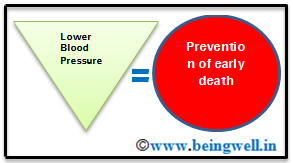Lowering blood pressure may prevent early death

According to a new study, if upper (systolic) blood pressure is kept at below 120 mm Hg, 107,500 early deaths could be prevented every year.
Systolic blood pressure refers to the pressure in the arteries when the heart contracts to push out blood to various parts of the body.
The diastolic (lower blood pressure), refers to the pressure between the beats.
Current guidelines recommend keeping systolic blood pressure below 140 mm Hg.
However, the results also revealed that there was a 27 per cent reduction in mortality from all causes when systolic blood pressure was lowered to below 120, compared to the standard treatment of lowering blood pressure to below 140 mm Hg.
‘If fully implemented, intensive lowering of systolic blood pressure could prevent about 107,500 deaths per year,’ said researchers at Loyola University in Chicago.
For the study, published in the journal Circulation, the team enrolled more than 9,350 adults aged 50 and older who had high blood pressure and were at high risk for cardiovascular disease.
High blood pressure, or hypertension, is a leading risk factor for heart disease, stroke, kidney failure and other health problems.
While saving lives, an intensive blood pressure regimen also would cause serious side effects, the researchers said.
The study estimated that approximately 56,100 more episodes of low blood pressure, 34,400 more episodes of fainting and 43,400 additional electrolyte disorders would occur annually with implementation of intensive systolic blood pressure lowering in US adults.
But most of these effects do not have lasting consequences and are reversible by lowering blood pressure medications, the researchers noted.
